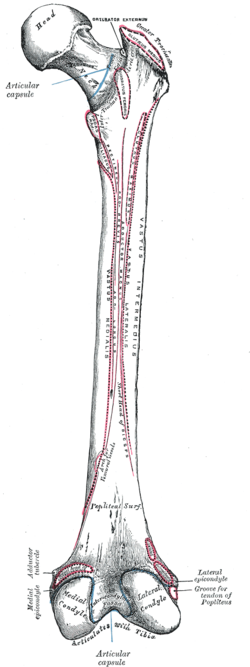Femoral shaft
| Body of femur | |
|---|---|

Right femur. Anterior surface.
|
|

Right femur. Posterior surface.
|
|
| Details | |
| Identifiers | |
| Latin | corpus femoris |
| Dorlands /Elsevier |
s_09/12732595 |
| TA | A02.5.04.012 |
| FMA | 32847 |
|
Anatomical terms of bone
[]
|
|
The body of the femur (or shaft), almost cylindrical in form, is a little broader above than in the center, broadest and somewhat flattened from before backward below. It is slightly arched, so as to be convex in front, and concave behind, where it is strengthened by a prominent longitudinal ridge, the linea aspera.
It presents for examination three borders, separating three surfaces.
Of the borders, one, the linea aspera, is posterior, one is medial, and the other, lateral.
The linea aspera is a prominent longitudinal ridge or crest, on the middle third of the bone, presenting a medial and a lateral lip, and a narrow rough, intermediate line.
Above, the linea aspera is prolonged by three ridges.
The lateral ridge is very rough, and runs almost vertically upward to the base of the greater trochanter.
It is termed the gluteal tuberosity, and gives attachment to part of the glutæus maximus: its upper part is often elongated into a roughened crest, on which a more or less well-marked, rounded tubercle, the third trochanter, is occasionally developed.
The intermediate ridge or pectineal line is continued to the base of the lesser trochanter and gives attachment to the pectineus; the medial ridge is lost in the intertrochanteric line; between these two a portion of the iliacus is inserted.
Below, the linea aspera is prolonged into two ridges, enclosing between them a triangular area, the popliteal surface, upon which the popliteal artery rests.
Of these two ridges, the lateral is the more prominent, and descends to the summit of the lateral condyle.
The medial is less marked, especially at its upper part, where it is crossed by the femoral artery.
It ends below at the summit of the medial condyle, in a small tubercle, the adductor tubercle, which affords insertion to the tendon of the adductor magnus.
From the medial lip of the linea aspera and its prolongations above and below, the vastus medialis arises; and from the lateral lip and its upward prolongation, the vastus lateralis takes origin.
...
Wikipedia
